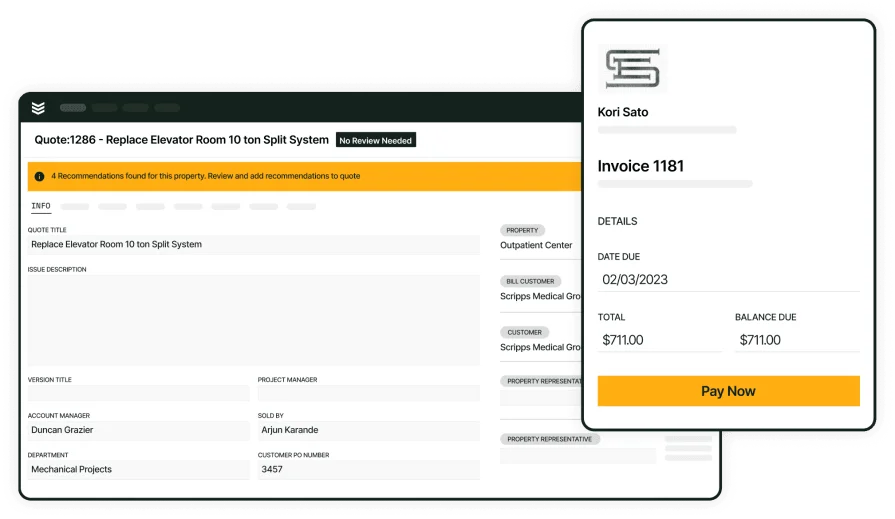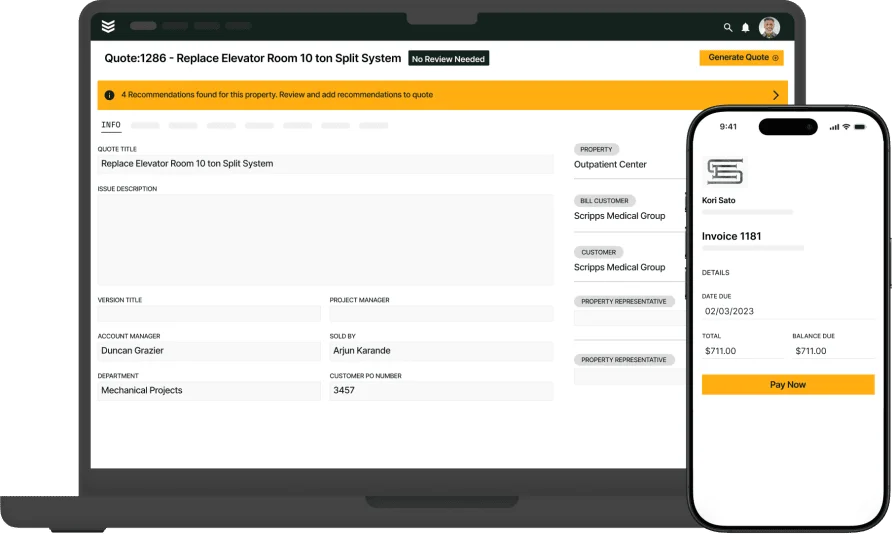When you're bidding on electrical jobs, the last thing you want is guesswork. A tight, detailed bid can make the difference between landing the project or getting passed over. Whether you're new to estimating or tightening up your process, the right examples can point you in the direction of better margins and fewer headaches.
That’s what this guide is for. We’ll break down what strong electrical bid examples include, where to find them, and how to create your own that actually win you more work. If you’re working in the electrical industry, this guide will help you level up your bidding process—fast. Here’s what we’ll cover:
- 10 key components to look for in an electric bid example
- 10 best electrical bid examples to base your own on
- 7 tips for creating electrical bids that land you more jobs
A strong electrical bid sets the tone for how you’ll handle the job from start to finish. In the next section, we’ll break down the 10 key components every electrical bid should have. Whether you're customizing your own or reviewing someone else’s, these are the details that separate solid bids from sloppy ones.
10 key components to look for in an electric bid example
A solid electrical bid doesn’t leave room for guessing. It spells out exactly what the job covers, what it costs, and how it’ll get done. Whether you're reviewing a sample or building your own, these are the parts that matter. Nail these, and you're already ahead of most.
- Scope of work – Lay out exactly what work is being done, where, and under what conditions. Clear scope avoids confusion and protects you from scope creep down the road
- Material breakdown – Itemize materials with quantities and pricing. This shows transparency and gives clients a reason to trust your estimate
- Labor estimate – Include labor hours by crew type or trade, and tie it back to real timelines. This helps the client understand cost structure and builds confidence in your schedule
- Permitting & inspection notes – Highlight any permits required and who's responsible for pulling them. Including this shows you're thorough and reduces surprises later
- Project timeline – A realistic timeline shows you're serious and have done this before. Include start and end dates, milestones, and possible delays
- Exclusions & clarifications – Spell out what’s not included to protect yourself. Be upfront about limits so there’s no wiggle room for misinterpretation
- Payment terms – Whether it’s progress payments or 30-day net, outline when and how you expect to be paid. Clarity here avoids late payments and awkward conversations
- Warranty info – Include warranty coverage for labor and materials. Clients want to know you’ll stand by your work
- Change order process – Explain how changes are handled and billed. This helps avoid disputes and keeps both sides honest
- Contact information & license numbers – End with your business details, contact person, license number, and insurance info. This adds credibility and compliance peace of mind
Understanding what goes into a bid is only half the job. Seeing real examples brings those components to life. In the next section, we’ll look at actual electrical bid examples you can learn from—whether you're starting fresh or sharpening what you’ve already got. These samples show different approaches, styles, and formats that can help you build bids that get noticed and get accepted.
10 best electrical bid examples to base your own on
Whether you're bidding on a major commercial install or a small tenant improvement job, seeing real examples helps you shape your own. These samples range from highly detailed to short and sweet, giving you options to match your project scope, client type, and workflow.
1. BuildOps
Type: A complete bid and quoting solution with built-in estimating, scheduling, and proposal generation tools
Most Useful For: Commercial contractors
This example shows how electrical contractors can handle complex bids without jumping between spreadsheets and PDFs. The proposal layout includes a line-by-line material and labor breakdown, scope of work, exclusions, and custom branding. Built for speed and clarity, it’s a solid reference if you’re managing high volumes or fast-turnaround jobs.

Take a closer look
We help contractors manage labor, materials, and scope—without the clutter.
2. Sample.net
Type: Fully filled-out PDF proposal showing a breakdown of labor, materials, and job scope
Most Useful For: General contractors or subs handling straightforward installation projects
This example covers the essentials—a clearly defined scope of work, estimated costs, timeline, and payment terms. It’s a solid choice if you’re handling mid-size or repetitive jobs and need something clean and readable. But if you're quoting multi-phase commercial work with multiple teams, you may need something more dynamic and integrated.
Check out this Sample.net proposal samples—it’s fully filled out and ready to use as a reference for layout, pricing format, and structure.
3. Proposable
Type: Web-based proposal example with detailed service breakdown and digital approval features
Most Useful For: Small-to-mid electrical contractors bidding residential or light commercial work
This sample stands out for its structured layout—sectioned scope, project timeline, pricing, and contract terms all in one scroll. It’s easy for clients to review and approve online. That said, it’s more geared toward smaller projects and may not have the flexibility or depth required for multi-trade or long-duration commercial jobs.
Check out Proposable’s example—a solid reference for writing client-facing proposals that look sharp and get approved faster.
4. Tradify
Type: Downloadable PDF template with customizable fields
Most Useful For: Contractors seeking a straightforward, printable bid format
Tradify's template offers a clear-cut structure for presenting proposals, making it easy to customize for different clients. It's ideal for those who prefer a traditional approach. However, it may lack the dynamic features needed for more complex project management and tracking.
Explore Tradify’s electrical bid example to streamline your proposal process with a professional touch.
5. PandaDoc
Type: Comprehensive digital proposal with e-signature capabilities
Most Useful For: Firms handling repeat clients or recurring bid formats
PandaDoc's example emphasizes customization, allowing users to save and reuse sections like scope of work, licensing, and warranty information. The final proposals are polished and consistent, featuring client branding and dynamic pricing tables. However, for contractors seeking integrated estimating and job tracking features, it might require additional tools to fill those gaps.
Take a look at PandaDoc’s electrical bid example to see how customizable templates can enhance your proposal process.
6. Housecall Pro
Type: Printable bid template with built-in formulas
Most Useful For: Electricians needing quick, accurate estimates
Housecall Pro's template simplifies the bidding process with step-by-step instructions and built-in formulas for calculations. It's excellent for creating accurate bids quickly. However, it may not offer the comprehensive project management features required for larger-scale operations.
Check out Housecall Pro's bid template examples to expedite your estimating process with ease.
7. Template.net
Type: Editable online bid proposal with detailed sections
Most Useful For: Contractors seeking a customizable template for various project types
Template.net provides a detailed bid proposal template that's easy to edit online. It's suitable for a range of projects, offering sections for scope, timeline, and costs. However, it may lack the advanced features needed for complex project tracking and client management.
Explore Template.net's electrical bid examples to tailor your proposals to different project requirements.
8. SlideTeam
Type: PowerPoint-based bid proposal with visual aids
Most Useful For: Contractors presenting bids in meetings or pitches
SlideTeam's template offers a visually engaging format for presenting bid proposals. It's ideal for in-person presentations, allowing for clear communication of project details. However, it may not be as practical for day-to-day bid submissions or digital approvals.
Check out SlideTeam's bid electrical template examples to enhance your proposal delivery in meetings.
9. ProposalTemplate.ai
Type: Comprehensive PDF proposal with structured sections
Most Useful For: Contractors seeking a detailed, ready-to-use bid format
This template offers a thorough structure, including title page, executive summary, scope of work, and cost estimates. It's beneficial for creating detailed proposals. However, it may require manual adjustments for each project, lacking automation features.
Take a quick look at ProposalTemplate.ai's electrical bid template examples to craft comprehensive proposals with ease.
10. BestTemplates
Type: Downloadable Word and Pages template with pre-filled content fields
Most Useful For: Contractors who prefer a fully editable format they can adjust project to project
This bid proposal template offers a straightforward structure in familiar software formats, making it easy to customize without a learning curve. It includes key sections like project scope, material and labor estimates, and terms. It's a good fit for shops that don’t need advanced software but still want something polished and easy to replicate. That said, it's a static file—so if you're managing multiple bids or juggling client revisions, this one might slow you down.
Check out BestTemplates’ electrical bid example to download a simple, customizable layout you can make your own.
Expert Tip
Liked the examples in this guide? Take the next step with a practical electrical bid template you can customize for your own jobs. It’s built to reflect the same structure, detail, and clarity found in the best bid examples—so you can stop starting from scratch and start sending bids that win work faster.
7 tips for creating electrical bids that land you more jobs
Let’s face it—winning a job doesn’t come down to just being the cheapest. Clients look for clear, professional bids that show you know what you’re doing and can deliver without surprises. From how you present pricing to how fast you send it out, every detail can make a difference. These tips are geared for electrical contractors looking to tighten up their bidding process and get more contracts signed.
1. Be specific with your scope of work
Don’t leave room for interpretation. A clear, itemized scope helps clients understand exactly what’s included—and what’s not. Break the job into specific tasks and clarify any assumptions. Want a solid reference point? These electrical contractor invoice examples show how detailed documentation should look, and it's the same level of clarity you want in your bids.
2. Use a professional template every time
A clean, repeatable format signals that you’re organized and professional. It helps your team stay consistent and reduces errors when quoting similar jobs. Your template should include key sections like scope, pricing, timeline, exclusions, and payment terms—and it should be fast to update job-to-job.
3. Build in room for change orders
Every bid should explain how scope changes will be handled. Outline the approval process, pricing expectations, and documentation method. This protects your margins, keeps everyone aligned, and shows the client you’re prepared for the unexpected. It also helps avoid those awkward “I thought that was included” conversations once the job is already in motion.
4. Break out materials and labor separately
Clients want transparency. Separate line items for labor and materials help justify costs and allow easy updates if prices shift. If you’re using an electrical work order invoice, much of this breakdown can be reused in your bid format, keeping things efficient. A well-organized breakdown also builds trust by showing exactly where their money is going.
5. Don’t wait days to send your bid
Speed matters. Aim to send your bid within 24 hours of the walkthrough. Using tools like an electrical contractor scheduling app helps you capture job info and sync it with your quoting process—so nothing gets lost and you stay ahead of the competition. Fast follow-up signals you’re organized and ready to work, which is a major advantage.
6. Add photos and diagrams when possible
Including visuals makes your bid easier to understand. Photos of existing conditions or simple diagrams show that you’ve done your prep and thought through the job. It adds clarity and credibility—especially for clients comparing multiple bids. Plus, it makes your proposal more memorable and professional without requiring much extra effort.
7. Always include exclusions
Clearly list what’s not covered in the bid. This helps avoid confusion later and protects your team from absorbing unexpected costs. Be upfront about exclusions, assumptions, and client responsibilities so there’s no gray area. A well-written exclusions section can save you from back-end disputes that cut into your profit.
Whether you're quoting a quick panel swap or bidding out a major tenant improvement, the electrical bidding process comes down to consistency, clarity, and speed. From breaking down materials and labor to clearly outlining change orders, each of these practices gives your clients more confidence in your work—and gives your team fewer headaches down the line.
The challenge? Most tools on the market only cover part of the process. Some help you quote, others handle scheduling, but very few do it all. That’s where having a platform built specifically for commercial contractors makes a real difference. With BuildOps, electrical teams can manage estimates, work orders, scheduling, and job tracking—all in one place. So when it’s time to turn that bid into a job, everything’s already connected.

See if BuildOps is a good fit
BuildOps helps contractors send more bids and land more jobs—faster.







